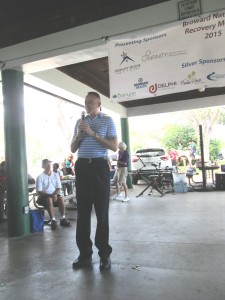
This article was originally posted on TheBody.com on David's blog "Riding the Tiger: Life Lessons from an HIV-positive Therapist"
Public apprehension about recreational drugs, especially those that impact HIV, seems to come in waves that swell with increasing alarm and then peak and fade away, always to be replaced by the next "drug du jour." Heroin, cocaine, and methamphetamine, each with a well-deserved reputation for putting people at risk for HIV or, if HIV positive, for interfering with their ability to properly manage their health, have all gained notoriety in recent years.
While the popularity of various illegal substances rises and falls, alcohol consistently remains the granddaddy of recreational drugs. New forms of alcoholic drinks began appearing in the 1980s, first with wine coolers and then flavored alcoholic beverages (that's FAB, for short) and energy drinks. They have gained popularity, especially among youth. Now, just months after the FDA urged the removal of caffeine from alcoholic drinks such as 4Loko, beverage companies are once again shape-shifting their fruity-tasting concoctions and they're literally bigger than ever: they've been supersized. The new packaging, still largely targeting young (and often underage) drinkers, features a 23.5 ounce can with a 12% alcohol content. That's equivalent to four or five beers. They're cheap, accessible, and highly potent.
Why is this a concern? The numbers tell the story. 10.7 million underage youth drink alcohol, and about 70% of those youth binge drink, resulting in harmful physical consequences, poor judgment, lower inhibitions, and an abundance of high risk sexual behaviors. And the concerns extend beyond youth. Excessive consumption of alcohol is a significant health concern for everyone, but especially for those at higher risk for, or living with HIV.
Some speculate that if alcohol were introduced today it would never be legalized. It is, of course, here to stay. Because it is so easily available, socially acceptable, relatively cheap, and widespread, it's easy to forget its risks, which are really worth a second look. It's not fair, however, to demonize alcohol. There is little evidence that moderate drinking (described in most literature as one drink per day) impacts persons living with HIV. Excessive drinking, however, can be destructive for persons living with HIV for a number of reasons. Here are a few:
Excessive Alcohol Weakens the Immune System
The physical toll of too much alcohol is expressed in a number of ways. It taxes the liver, which is already working overtime metabolizing medications. This situation is made even worse, of course, when someone is also dealing with Hepatitis. Alcohol also interferes with the body's ability to create white blood cells and is disruptive to other factors necessary for health such as hydration, nutrition, motivation for exercise, and sleep.
Interactions with medications
As noted above, alcohol can affect the absorption of medications necessary to fight the virus. This can result in reduced efficacy, more unanticipated reactions, and alteration of the effects of some drugs. Alcohol also results in medication adherence problems due to altered states and inconsistent behavior.
Risky activities
Speaking of inconsistent behavior, alcohol impacts reflexes, inhibition, and judgment, which can clearly compromise the health and wellness of the drinker. This can lead to poor sexual choices and a loss of motivation for safer sex. Despite that fact that alcohol impairs physiological sexually functioning, people under the influence can still engage in enough risky sex to get them in trouble!
Mood
Alcohol is a central nervous system depressant which directly affects mood. It can be misused to numb feelings of sadness, anger, and fear, and can quickly become a crutch on which people depend to avoid uncomfortable emotions. Persons living with HIV are at greater risk for addictions of all kinds, and it is incumbent on anyone who is HIV positive to be vigilant about their alcohol consumption.
"I'm recovering from drugs and alcohol isn't my problem!"
I have patients in recovery from amphetamines who question why they need to abstain from alcohol. Many proclaim their dislike of an alcohol high: slow and sluggish. They prefer the perceived clarity of amphetamines and see no reason why they can't indulge in a beer or glass of wine with their friends. After all, they say, alcohol isn't the problem, it's meth (or cocaine). Unfortunately many discover that a few beers in the bar with friends reduces their ability to resist the impulse to use their drug of choice (such as cocaine and meth) and their resilience and sometimes their recovery crumbles after a few drinks.
Despite the numerous risks, excessive alcohol consumption remains a common problem that requires routine monitoring. Most people won't volunteer this information unless specifically asked, and even then their responses may be less reliable until a level of trust is established. There are quick screening tools for alcohol such as the MAST (Michigan Alcohol Screening Test) that are effective and easy to administer. Of course it is dangerous for a heavy drinker to just stop using alcohol, but with proper medical supervision there is no reason for excessive drinking to jeopardize anyone's health.






